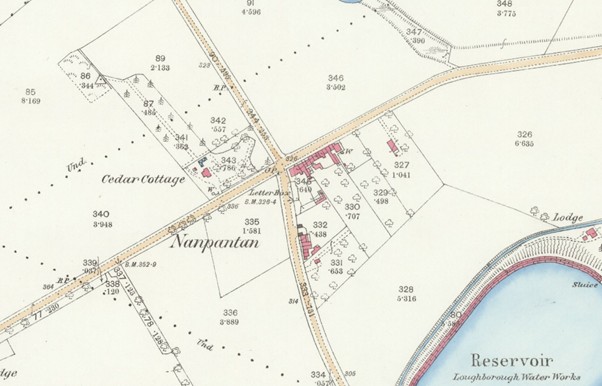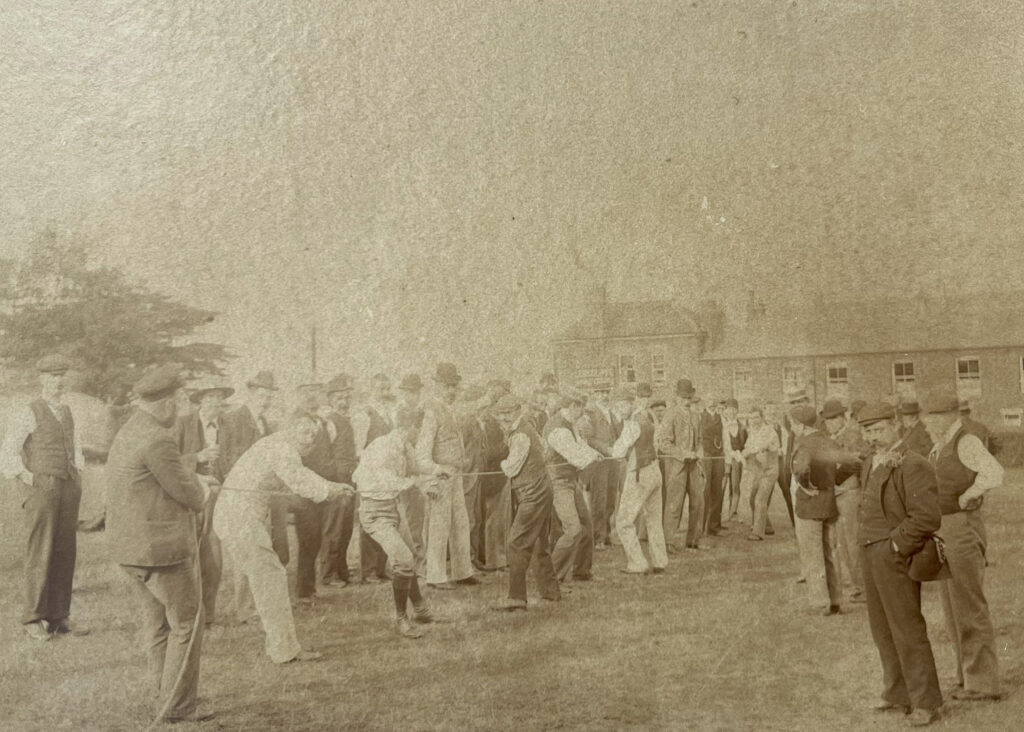‘The holiday resort of the people’: Exploring the History of the ‘Community at the Crossroads’
Description
In this blogpost, Dr Pamela Fisher, County Editor of the Victoria County History (VCH) project in Leicestershire, describes a project on a tiny midland settlement and shows how VCH research engages with local communities and, in partnership, can expand their, and our understanding of past places.
In 2025, the VCH celebrates the publication of its 250th ‘Big Red Book’, Westmorland volume I, Lonsdale Ward. These large, important monographs are just one output of VCH work. This blogpost explores the grass roots of VCH research in another part of England, Loughborough. The history of the market and university town of Loughborough will be the subject of two paperbacks being produced by Leicestershire VCH. Final revisions are now underway for the first of these, a social and cultural history of the town since 1750.
Medieval Loughborough was never a borough, the second element of the place-name is derived from burh—a fortified place. The town became a municipal borough in 1888, with the farmland in the south of the parish excluded from the new borough boundary to become the civil parish of Nanpantan in 1894.
In addition to the scattered farmsteads the new civil parish also included a small settlement clustered around a crossroads. Until 1828 the land around the crossroads was part of Charnwood Forest, an upland area to the south of Loughborough with outcropping rocks, thin soils and patches of woodland that formed the unenclosed ‘waste’ of the surrounding manors. Earlier maps show no buildings at the crossroads, but eight small plots were laid out in the eastern quadrant in the 1828 enclosure award and allotted to six different people. These became the sites of the oldest buildings in this vicinity.
The distinctive landscape of Charnwood Forest is under threat from the growing need for housing, due to its proximity to the cities of Leicester, Nottingham and Derby, and from quarrying, as its hard rocks have a range of uses, from buildings to rail ballast and asphalt. Yet Charnwood’s rocks are of international importance. Some date from Precambrian times (Edicaran period) and contain some of the oldest animal fossils found anywhere in the world, providing evidence for life on earth 560 million years ago. A stakeholder group of public and private sector bodies was awarded lottery funding in 2000 and established Charnwood Forest Geopark to investigate and promote the heritage. An application for UNESCO Geopark status is being submitted in 2025.
<figure class="wp-block-image size-large">
 <figcaption class="wp-element-caption">Trees and rocks (Outwoods Brecchia Member) in Nanpantan</figcaption></figure>
<figcaption class="wp-element-caption">Trees and rocks (Outwoods Brecchia Member) in Nanpantan</figcaption></figure>In the final months of 2024 Charnwood Forest Geopark offered small grants from their lottery funding for community heritage projects within their area, which includes Nanpantan. Leicestershire VCH Trust applied for a grant for a community project to investigate Nanpantan’s history. Our application was successful, and we advertised locally and on social media for volunteers who would meet in a converted outbuilding at Home Farm, Nanpantan. Within a few days more than 30 people had offered to help. Some were experienced local or family historians, others were complete beginners.
We wanted to know more about ‘the community at the crossroads’, and also Nanpantan’s businesses—principally the farms and a pub. With just three months to complete the research and put on a final public display we planned to focus on census records and online newspapers, both accessible free of charge on PCs in Loughborough library, together with trade directories, sales particulars for farms held in the county record office, and the Second World War farm surveys held at The National Archives, Kew. We anticipated slotting some of the information collected into our first book, with the farm details helping towards our second Loughborough paperback, an economic history of the parish since 1750. A surprising finding concerning the pub took the project in an unexpected direction.
<figure class="wp-block-image size-full is-resized">
 <figcaption class="wp-element-caption">Nanpantan in 1883, from OS 25” Leics. XVII.11, courtesy of https://maps.nls.uk/</figcaption></figure>
<figcaption class="wp-element-caption">Nanpantan in 1883, from OS 25” Leics. XVII.11, courtesy of https://maps.nls.uk/</figcaption></figure>Nanpantan remained a very small settlement in 1883. Although only two miles from Loughborough, which then had nearly 15,000 residents, the Ordnance Survey map shows fewer than two dozen properties at Nanpantan crossroads (see image). One of these was a pub, the Queen’s Head. Its owner and holder of its beer-house licence, widow Caroline Hopkins, died in 1883, and the property was offered for sale. Loughborough publican John Bennett wished to buy and extend the property, subject to the magistrates agreeing a licence for him to sell beer and spirits.
Newspaper reports found by our volunteers reveal that Bennett’s application had the written support of ‘several landowners in the neighbourhood, the rector of the parish, six members of the Loughborough Local Board, and others’ including ‘All the residents’ of Nanpantan. Police Superintendent Peberdy appeared in person and told the magistrates that he had visited the premises ‘a week or two ago’ and saw ‘about a thousand people sitting on the roadside outside the applicant’s house’. Bennett added that ‘visitors averaged about 600 weekly during the summer season’ and there was little shelter for them if it rained. His licence application was approved.
Although its history has been forgotten today, Nanpantan was described in other newspapers from the 1890s as ‘The holiday resort of the people’. We have found details of factory outings from Loughborough to Nanpantan as early as the 1820s, weekday trips to Nanpantan for ‘gentlemen’ from Loughborough from the 1860s and working people from Leicester and parts of south Derbyshire and south Nottinghamshire visiting Nanpantan and Charnwood Forest for a day from the 1880s and 1890s. Bennett renamed the business the Longcliffe Hotel and offered lunches and teas for such trips, also laying on entertainments, including bands for dancing, and hiring a field on the opposite side of the road for sports and games, including races and tugs-o’-war. He extended the building to provide tables for 500 diners and stabling for 80 horses. There was even enough business in Nanpantan to support a rival – a Temperance Hotel opened c.100 metres away in 1896, offering ‘Grand Pavilion Accommodation for 400 Persons’, with both businesses apparently prospering until the First World War.
<figure class="wp-block-image size-large">
 <figcaption class="wp-element-caption">Tug-o’-war in the field rented by the Longcliffe Hotel, with the participants probably being a works party on an excursion. The long two-storey dining rooms of the Longcliffe can be seen behind the competing teams. The Cedar tree in the image stood at the crossroads, hence the name of Cedar Cottage in the 1883 map. Courtesy of the Record Office for Leicestershire, Leicester and Rutland, DE6861/80.</figcaption></figure>
<figcaption class="wp-element-caption">Tug-o’-war in the field rented by the Longcliffe Hotel, with the participants probably being a works party on an excursion. The long two-storey dining rooms of the Longcliffe can be seen behind the competing teams. The Cedar tree in the image stood at the crossroads, hence the name of Cedar Cottage in the 1883 map. Courtesy of the Record Office for Leicestershire, Leicester and Rutland, DE6861/80.</figcaption></figure>Our volunteers were all local and included Nanpantan residents who were as surprised as we were by these discoveries. So too were the residents who attended our public event in March. Our findings will add another layer of interest to our two Loughborough paperbacks, and we are also writing a separate article for publication.
We are very grateful to all our volunteers and others involved with this ‘mini-project’ (which turned out to be anything but ‘mini’), and to Charnwood Geopark and the National Lottery for their financial support.
<figure class="wp-block-image size-large is-resized">
 </figure>
</figure><figure class="wp-block-image size-large is-resized">
 </figure>
</figure><figure class="wp-block-image size-full is-resized">
 </figure>
</figure>Pamela Fisher is County Editor for VCH Leicestershire, and has previously produced parish histories for the VCH on Castle Donington (with J Michael Lee, 2016), Buckminster and Sewstern (2017), (Ibstock 2020) and Lutterworth (with Andrew Watkins, 2022), copies of which are available to <a href="https://www.history.ac.uk/research/victoria-county-history/counties-z/leicester





